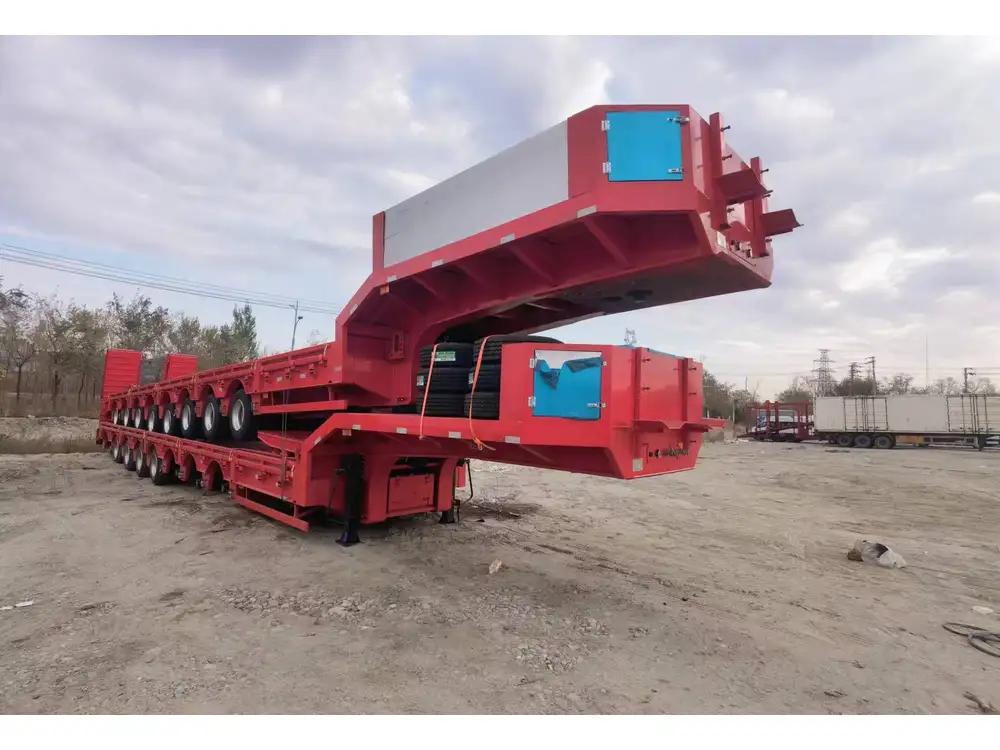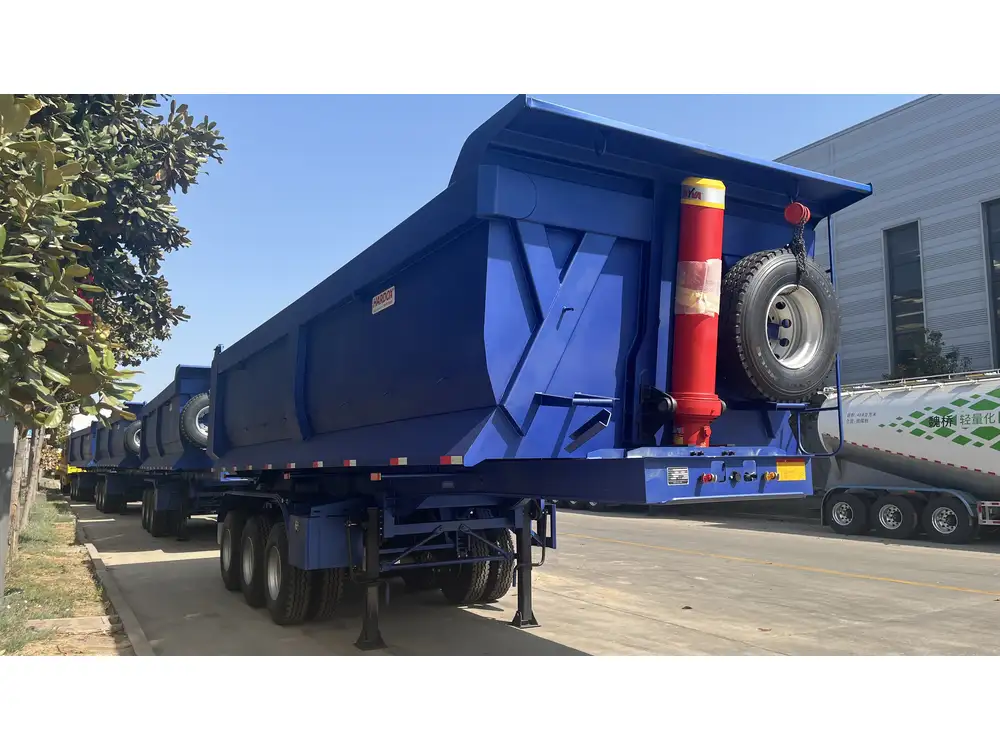Dump trailers are pivotal in the transportation industry, facilitating the effortless movement of materials such as sand, gravel, soil, and waste. However, the efficacy of these trailers largely hinges upon strategic placement of critical components, particularly the hydraulic cylinder. This guide elucidates the optimal positioning of the cylinder on a dump trailer, ensuring safety, efficiency, and enhanced performance.
Understanding the Functionality of Hydraulic Cylinders in Dump Trailers
Hydraulic cylinders are essential to the operation of dump trailers. They convert hydraulic pressure into mechanical force, lifting the trailer bed to allow for efficient unloading of materials. The configuration of these cylinders directly influences the trailer’s stability, load-bearing capacity, and overall operational effectiveness.
Key Functions of Hydraulic Cylinders:
- Lifting and Lowering Mechanism: The primary function of the cylinder is to raise the trailer bed and subsequently lower it for unloading purposes.
- Load Distribution: Proper placement ensures that the weight is evenly distributed, minimizing strain on the trailer and improving safety during operation.
- Stability: The positioning of the cylinder can significantly affect the trailer’s center of gravity and stability, especially when lifting heavy loads.

Factors to Consider When Placing the Cylinder
1. Design of the Dump Trailer
The design of the dump trailer plays a crucial role in cylinder placement. Most manufacturers offer specific designs that dictate where the hydraulic cylinder should be installed. Certain factors to consider include:
- Type of Trailer: Single-axle vs. dual-axle trailers may require different placements.
- Trailer Bed Length and Width: The size of the trailer bed can influence how far the load shifts during operation.
- Weight Ratings: Adhering to manufacturer specifications ensures compliance with safety standards.
2. Center of Gravity
The center of gravity (CG) is an essential consideration that affects how the trailer behaves when loaded and unloaded. Placing the cylinder correctly helps maintain an optimal CG, ensuring that the trailer remains stable during lifting. Factors influencing the CG include:
| Factor | Impact |
|---|---|
| Load Weight | Heavy loads shift the CG towards the rear; cylinder placement can help balance this shift. |
| Load Distribution | Uneven loads can lead to side tilting; centralizing the load can improve stability during operations. |
| Trailer Dimensions | The length and width can complicate CG issues; accurate positioning is essential for effective lifting and unloading. |

3. Types of Hydraulic Cylinders
The effectiveness of the dump trailer also depends on the type of hydraulic cylinder selected. Common types include:
- Single-Acting Cylinders: These are less complex and ideal for lightweight operations.
- Double-Acting Cylinders: More powerful and commonly used in heavy-duty applications; they offer controlled lifting and lowering.
- Telescopic Cylinders: Provide extended reach; perfect for high dump trailers.
4. Load Conditions
The load conditions under which the dump trailer operates significantly affect how the cylinder should be placed. Some considerations include:
- Type of Material: Different materials (e.g., dirt vs. gravel) may shift differently, affecting stability upon unloading.
- Frequency of Use: More frequent use may require a more robust setup to handle consistent strain.
Optimal Cylinder Placement Strategies

Standard Placement Locations
A variety of configurations exist for optimal cylinder placement, with each having its advantages and drawbacks:
Front-Mounted Cylinders
- Description: Positioned at the front of the trailer.
- Advantages: Enhanced visibility during operation, increased lifting power.
- Disadvantages: Higher potential for tipping under loads.
Rear-Mounted Cylinders
- Description: Placed toward the rear of the dump trailer.
- Advantages: Better stability when unloading; reduced risk of tipping.
- Disadvantages: Limited visibility and potential strain on the rear axle.
Center-Mounted Cylinders
- Description: Installed at the center of the dump bed.
- Advantages: Balanced operation—ideal for heavy, evenly distributed loads.
- Disadvantages: More complex hydraulic connections may be required.
Adjustable Cylinder Placement
Some advanced trailers allow for adjustable cylinder placements, providing flexibility based on specific operational requirements. This feature offers the advantage of adapting to various load types, optimizing efficiency based on the task at hand.
Tips for Installation and Maintenance
To ensure optimal performance of the hydraulic cylinder and the dump trailer, consider the following best practices during installation and maintenance:

Hydraulic Connections
- Secure Connections: Ensure all hydraulic lines are secure and leak-free to maintain pressure and efficiency.
- Proper Sizing: Use appropriate hose sizes; overly long or thin hoses can decrease performance.
Routine Maintenance
- Regular Inspections: Check cylinder seals, mounts, and connections regularly for wear and tear.
- Fluid Levels: Maintain proper hydraulic fluid levels, ensuring smooth operation and preventing damage.
Firm Mounting
- Mounting Technique: Ensure that the cylinder is mounted securely; even slight movement can compromise lifting capability.
- Material Choice: Utilize high-quality materials for mounting brackets to withstand stress.

Troubleshooting Common Issues
Loose Cylinder Mounts
Symptoms:
- Inconsistent lifting capability.
- Noisy operation.
Solution:
- Inspect and tighten all bolts.
Hydraulic Leaks
Symptoms:
- Loss of lifting power.
- Observable fluid puddles.
Solution:
- Check for damaged lines and replace them as necessary.

Uneven Lifting
Symptoms:
- Trailer bed lifts at an angle.
Solution:
- Analyze load distribution and adjust accordingly; ensure proper cylinder placement and alignment.
Conclusion: Maximizing Efficiency with Correct Cylinder Placement
Selecting and positioning the hydraulic cylinder on your dump trailer is not just a matter of preference; it’s a fundamental aspect influencing operational efficiency, safety, and overall performance. By considering factors such as design, center of gravity, load conditions, and cylinder type, we can strategically determine the ideal location for the cylinder. Whether opting for front-mounted, rear-mounted, or center-mounted configurations, insights into installation and maintenance practices pave the way for longevity and reliability.
When we maximize the efficiency of our dump trailers through informed decision-making and proactive maintenance, we bolster our capacity to tackle challenging tasks while ensuring wholesomeness and safety in our operations. Let us equip ourselves with the knowledge necessary to make the best choices in hydraulic cylinder placement, optimizing our resources for the benefit of our enterprises.



